Jan 28 2016
Researchers from Northwestern University have discovered that crumpled graphene balls possess the ability to be a lubricant additive. Improperly lubricated automobile engine is detrimental to the environment and hard on the pocket. About 15% of the fuel consumption is spent overcoming friction in the engine and transmission in the average car. The higher the friction, the harder the gears have to work in order to move, meaning the car burns excess fuel and emits additional carbon dioxide into the atmosphere.
 Image Credit - Sspopov/Shutterstock.com
Image Credit - Sspopov/Shutterstock.com
“Every year, millions of tons of fuel are wasted because of friction,” said Northwestern Engineering’s Jiaxing Huang, associate professor of materials science and engineering. “It’s a serious problem.”
Although oil is applied to minimize the friction, researchers are eager to find additives to improve the performance of oil. Huang and his team conducted a number of tests, which revealed that oil modified with crumpled graphene balls performed better than some commercial lubricants by 15 percent, in terms of minimizing friction and the wear degree on steel surfaces.
Crumpled graphene balls were discovered five years ago by Huang. The balls are a unique type of ultrafine particles that look like crumpled paper balls. These particles can be created by drying tiny water droplets containing graphene-based sheets.
Capillary force generated by the evaporation of water crumples the sheets into miniaturized paper balls. Just like how we crumple a piece of paper with our hands.
Jiaxing Huang, Associate Professor, Materials Science and Engineering, Northwestern University
After making this discovery, Huang explained the concept to Chung in Hong Kong by crumpling a napkin and juggling it.
When the ball landed on the table, it rolled. It reminded me of ball bearings that roll between surfaces to reduce friction.
Yip-Wah Chung, Professor, Materials Science and Engineering, Northwestern University
Carbon nanoparticles have been studied previously to see if they can be used to enhance the lubrication of oil. This wasn't successful, instead of dispersing in oil the particles clumped together, making the nanoparticles less effective for lubrication. The particles could jam between the gear’s surfaces leading to severe aggregation that increases wear and friction.
Researchers have tried to modify the particles using additional chemicals, called surfactants, in order to enable them to disperse. However, the problem could not be totally solved.
Under friction, the surfactant molecules can rub off and decompose. When that happens, the particles clump up again.
Yip-Wah Chung, Professor, Materials Science and Engineering, Northwestern University
The crumpled graphene balls have the ability to self-disperse without the use of any surfactants, due to their special shape. The pointy surfaces of the balls mean they cannot make close contact with each other. Even upon being squeezed together, they easily disperse again when agitated. Huang’s team also observed that the balls performance was not sensitive to their concentrations in the oil.
A few are already sufficient, and if you increase the concentration by 10 times, performance is about the same. For all other carbon additives, such performance is very sensitive to concentration. You have to find the sweet spot.
Jiaxing Huang, Associate Professor, Materials Science and Engineering, Northwestern University
The problem with finding a sweet spot is that, during operation, the local concentration of particles near the surfaces under lubrication could fluctuate. This leads to unstable performance for most other additive particles.
Q. Jame Wang, Professor, Medichanical Engineering
Going forward, the team will explore other advantages of using the crumpled graphene balls in oil, for example their use as carriers. The open spaces and high surface area of the ball-like particles enable them to be superior carriers for materials with other functions, such as corrosion inhibition.
The Northwestern team was supported by the Office of Naval Research, and the research was published online on January 25 in the Proceedings of the National Academy of Sciences. The research paper’s first author is Xuan Dou, a graduate student in Huang’s laboratory. The co-authors are Northwestern Engineering’s Yip-Wah Chung, professor of materials science and engineering, and Q. Jane Wang, professor of mechanical engineering.